
Volume XIX - Oaxaca
 Even before
we knew it could be done, the idea of taking a cooking class in
Oaxaca had planted itself in our brains. For me
the seed of it dated back a year earlier when Tackless II first pulled
into Mexico, in Oaxaca State’s seaside town of La Cruz, where
Don and I were reminded that not only did we really like Mexican
food, but that, after the culinary doldrums of Central America, that
we really liked to eat…period. The thing is, there are so many
unfamiliar things in the markets: the chiles, fresh and dried, the
cheeses, the mole pastes. Mexican food, in Mexico, doesn’t
come out of pre-packaged boxes and cans like it does in the good
old EUA (Estados Unidas Americano or USA). Or at least, not in the
familiar packages. Forging ahead on your own, without some guidance
can be daunting. Even before
we knew it could be done, the idea of taking a cooking class in
Oaxaca had planted itself in our brains. For me
the seed of it dated back a year earlier when Tackless II first pulled
into Mexico, in Oaxaca State’s seaside town of La Cruz, where
Don and I were reminded that not only did we really like Mexican
food, but that, after the culinary doldrums of Central America, that
we really liked to eat…period. The thing is, there are so many
unfamiliar things in the markets: the chiles, fresh and dried, the
cheeses, the mole pastes. Mexican food, in Mexico, doesn’t
come out of pre-packaged boxes and cans like it does in the good
old EUA (Estados Unidas Americano or USA). Or at least, not in the
familiar packages. Forging ahead on your own, without some guidance
can be daunting. 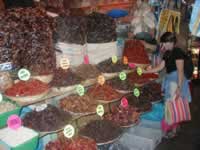
A year later when my friend
Jan Loomis (sv Meridian Passage) and I walked into Oaxaca’s centro from our bed and breakfast with
food on the brain, we fell in love quickly with this city. First
of all, the light was gorgeous, the sun’s low angle reflected
from clean planes of stone. Both Jan and I, although we knew better,
were persuaded by that evening light that ocean had to lie just at
the bottom of the street, a comforting illusion. Secondly of all,
the pace was laid back. There was no hustle bustle here and thanks
to a pedestrian mall, no traffic in sight, plus the zocalo with its
thick leafy trees offered up a rim of inviting café tables.
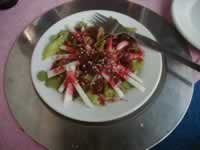 And then there was the
food. For supper that first evening we started simply with a tlayuda,
a giant Oaxaqueñan tortilla served
crisp with mole negro, cheese, tomatoes and lettuce like a black-faced
pizza. For breakfast the next morning in our B&B we had the even
more simple delight of a homemade corn tortilla folded into a piquant
ranchero sauce (essentially a chilaquile) And then there was the
food. For supper that first evening we started simply with a tlayuda,
a giant Oaxaqueñan tortilla served
crisp with mole negro, cheese, tomatoes and lettuce like a black-faced
pizza. For breakfast the next morning in our B&B we had the even
more simple delight of a homemade corn tortilla folded into a piquant
ranchero sauce (essentially a chilaquile)
By midday the next day,
however, after a tour to ancient Zapotec ruins, we were ravenous
for a real meal, and this hunger led us to
El Naranjo Trujano 203), recommended highly in several guidebooks.
We found a covered courtyard, simple tables and a fabulous menu.
I had a salad with a jamaica dressing (hibiscus flower) and the chef’s
specialty, poblano chiles stuffed with corn, zucchini and flor de
calabaza (squash blossoms). More unusual for Mexico, the chef Iliana
de la Vega came out herself to see how we were enjoying our meal.
From her we learned of the Wednesday cooking class, and from her
we got permission to squeeze into the last two places.
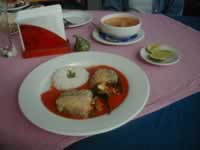 Eleven students – nine women and two men – from Canada,
the US, and England – rimmed the workspace in a separate teaching
kitchen and took turns helping to prepare a full course meal that
we would all later enjoy. The menu: Sopa de Tortilla, homemade chips
with two salsas, Rajas con crema, chicken breasts with mole rojo
(and rice) and mango mousse. To drink: agua de jamaica. (a chilled
brew of hibiscus flowers.) Eleven students – nine women and two men – from Canada,
the US, and England – rimmed the workspace in a separate teaching
kitchen and took turns helping to prepare a full course meal that
we would all later enjoy. The menu: Sopa de Tortilla, homemade chips
with two salsas, Rajas con crema, chicken breasts with mole rojo
(and rice) and mango mousse. To drink: agua de jamaica. (a chilled
brew of hibiscus flowers.)
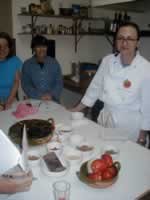 Iliana de Vega is a tall,
slender woman in the thirty-something range. As she taught, demonstrated
and oversaw our efforts, she shared
a number of anecdotes about herself, Mexican culture and Cocina Oaxaqueño.
Thanks to the barrier of rugged mountains that surrounds it, Oaxaca
has remained geographically isolated from Mexico to the north. This
inaccessibility, which has been blamed for keeping Oaxaca one of
the poorest states in the union, has also done it many favors. The
state’s indigenous peoples have had fewer intrusions on their
character, languages and handicrafts and likewise Oaxacan cuisine
has been able to preserve and develop its individuality. Although
Iliana herself grew up in Mexico City, her family would make the
laborious trip over the mountains to visit relatives in Oaxaca on
holidays. The new highway to the north, opened in 1994, brought Oaxaca
more into the Mexican mainstream, and now, with its unbeatable mix
of archaeological sites, indigenous crafts, pleasing climate, and
distinctive cuisine, it is surely one of the most popular non-beachside
tourist destinations in the country. Iliana de Vega is a tall,
slender woman in the thirty-something range. As she taught, demonstrated
and oversaw our efforts, she shared
a number of anecdotes about herself, Mexican culture and Cocina Oaxaqueño.
Thanks to the barrier of rugged mountains that surrounds it, Oaxaca
has remained geographically isolated from Mexico to the north. This
inaccessibility, which has been blamed for keeping Oaxaca one of
the poorest states in the union, has also done it many favors. The
state’s indigenous peoples have had fewer intrusions on their
character, languages and handicrafts and likewise Oaxacan cuisine
has been able to preserve and develop its individuality. Although
Iliana herself grew up in Mexico City, her family would make the
laborious trip over the mountains to visit relatives in Oaxaca on
holidays. The new highway to the north, opened in 1994, brought Oaxaca
more into the Mexican mainstream, and now, with its unbeatable mix
of archaeological sites, indigenous crafts, pleasing climate, and
distinctive cuisine, it is surely one of the most popular non-beachside
tourist destinations in the country.
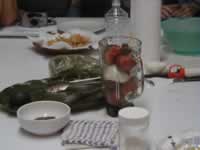 Oaxacan cuisine still
remains close to the vegetarian roots of Mexican cuisine. In the
past, traditional sources of animal protein were
few and far between, but the ancients discovered a process of soaking
the dried corn destined for tortillas with limestone to develop proteins!
When the Spaniards imposed themselves in the New World they also
imposed wheat, which they believed was better nutrition. Turned out
it was not. With a quick glance around at us, Iliana shared the saying
that “true Mexican culture stops where flour tortillas begin!” Oaxacan cuisine still
remains close to the vegetarian roots of Mexican cuisine. In the
past, traditional sources of animal protein were
few and far between, but the ancients discovered a process of soaking
the dried corn destined for tortillas with limestone to develop proteins!
When the Spaniards imposed themselves in the New World they also
imposed wheat, which they believed was better nutrition. Turned out
it was not. With a quick glance around at us, Iliana shared the saying
that “true Mexican culture stops where flour tortillas begin!”
A while later, though,
as we peeled luscious yellow mangos and tackled lively blanched
almonds to slip them from their skins, she told us
that the beloved “Tres Leches Cake” of Mexico and other
Latin American countries, was, in fact, an entry by some American
housewife in a recipe competition to introduce canned condensed milk!
On the other hand, rich flan custard was the product of a glut of
egg yolks available, owing to the fact that the gold leaf that encrusts
the interiors of Mexican churches was attached to the walls with
egg white!
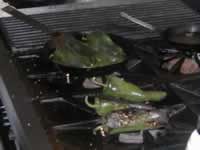 Someone asked who the
best known chefs in Mexico are, and Iliana laughed and said that
Mexican chefs don’t tend to be known
in Mexico as individuals. “Mexicans don’t care who cooks
the food, just that the food is good.” Even the idea of going
out to a restaurant to eat is a relatively new concept. Good cooking
is home cooking, and home cooking is still largely done from scratch.
She did mention Rick Bayliss and Diane Kennedy as name chefs doing
well by Mexican cuisine. Someone asked who the
best known chefs in Mexico are, and Iliana laughed and said that
Mexican chefs don’t tend to be known
in Mexico as individuals. “Mexicans don’t care who cooks
the food, just that the food is good.” Even the idea of going
out to a restaurant to eat is a relatively new concept. Good cooking
is home cooking, and home cooking is still largely done from scratch.
She did mention Rick Bayliss and Diane Kennedy as name chefs doing
well by Mexican cuisine.
With the mango mousses in the walk-in refrigerator to set, we set
about roasting and blending. For the mole rojo, the dried chiles
were wiped with a damp cloth, stemmed and seeded, and toasted very
quickly in a dry pan, and then put to soak. Tomatoes, unpeeled garlic,
and onion were also dry roasted whole. And finally a beautiful mix
of pecans, peanuts, sesame seeds and herbs were fried in oil. The
similarity treatment of the ingredients for moles to those for Indian
curries was not lost on me.
 At this point we began
to see why there are such huge stacks of Osterizer blenders in
the supermarkets here. It is the modern tool
of choice, edging out, for those with electricity, the old molillo,
a flat basin of stone with a stone rolling pin. First the roasted
chiles, with the addition of a little water, are pulsed into paste
and turned out into a hot pan with oil to fry. Next the nuts, herbs,
tomatoes, onion and garlic fill the jar and with the push of a button
are reduced to puree. You can strain or not strain according to you
preferences for texture as you add all to the pot. (Whenever using
cinnamon, Iliana advised, be sure to strain.) Once the mole was reduced,
we added chicken broth, salt, sugar, and “Oaxacan chocolate
to taste”. For twelve people, Oaxacan chocolate – which
is not like any chocolate in America, least of all baking chocolate! – “to
taste” was a whole 125 gram bar! At this point we began
to see why there are such huge stacks of Osterizer blenders in
the supermarkets here. It is the modern tool
of choice, edging out, for those with electricity, the old molillo,
a flat basin of stone with a stone rolling pin. First the roasted
chiles, with the addition of a little water, are pulsed into paste
and turned out into a hot pan with oil to fry. Next the nuts, herbs,
tomatoes, onion and garlic fill the jar and with the push of a button
are reduced to puree. You can strain or not strain according to you
preferences for texture as you add all to the pot. (Whenever using
cinnamon, Iliana advised, be sure to strain.) Once the mole was reduced,
we added chicken broth, salt, sugar, and “Oaxacan chocolate
to taste”. For twelve people, Oaxacan chocolate – which
is not like any chocolate in America, least of all baking chocolate! – “to
taste” was a whole 125 gram bar!
Interestingly, it was
not our duty to cook the chicken. In our cultures, the protein
would be the centerpiece, but here the sauce is the point,
and the “protein” is cooked as innocuously as possible.
Poached in this case.
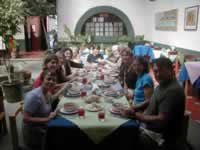 While the mole was simmering,
we moved on to roasting fresh Poblano chiles for the Rajas con
Crema. Iliana demonstrated the two best
techniques: the traditional one of charring the peppers over an open
flame, and the more efficient one of frying them in oil. In both
cases the blistered chiles are then cooled in a plastic bag, until
the skins just peel off. They definitely peel off more cleanly when
fried. The same technique gets chiles ready for chile rellenos or
other stuffed chiles recipes, but for rajas we cut off the stems,
seeded them and then cut them into strips. Then we sautéed
sliced onions, added the chile strips and then stirred in the lovely,
thick crema (crème fraiche) that is everywhere available in
Mexico along with ½ cup queso fresco (farmer’s type
cheese.) Scooped into warm tortillas, this is not a diet item. We
ate half of our output while still in the kitchen! While the mole was simmering,
we moved on to roasting fresh Poblano chiles for the Rajas con
Crema. Iliana demonstrated the two best
techniques: the traditional one of charring the peppers over an open
flame, and the more efficient one of frying them in oil. In both
cases the blistered chiles are then cooled in a plastic bag, until
the skins just peel off. They definitely peel off more cleanly when
fried. The same technique gets chiles ready for chile rellenos or
other stuffed chiles recipes, but for rajas we cut off the stems,
seeded them and then cut them into strips. Then we sautéed
sliced onions, added the chile strips and then stirred in the lovely,
thick crema (crème fraiche) that is everywhere available in
Mexico along with ½ cup queso fresco (farmer’s type
cheese.) Scooped into warm tortillas, this is not a diet item. We
ate half of our output while still in the kitchen!
Similarly, in preparation for the Sopa de Tortilla we fried up a
bunch of day old tortillas cut into strips. While this was happening,
we also whipped up three different salsas in the trusty blender,
which, of course resulted in many of the chips for the soup being
consumed.
 However, since this soup
is the one dish most likely to be made by folks “back home”, it is the recipe I will, with Iliana’s
permission, reproduce it here. Iliana does have a cookbook in the
works; I hope that she will let me know as soon as it is available
so I can add the info here. For sure, anyone even contemplating a
visit to Oaxaca, should, if you love food and cooking, plan to include
a day at El Naranjo. However, since this soup
is the one dish most likely to be made by folks “back home”, it is the recipe I will, with Iliana’s
permission, reproduce it here. Iliana does have a cookbook in the
works; I hope that she will let me know as soon as it is available
so I can add the info here. For sure, anyone even contemplating a
visit to Oaxaca, should, if you love food and cooking, plan to include
a day at El Naranjo.
Before we all sat down
to our feast, Iliana led us down the street to Oaxaca’s wonderful Central Mercado. Inside aisles tightly
packed with good things to buy, we were introduced to mind-boggling
piles of dried chiles and spices – many of them particular
to Oaxaca, baskets of dried jamaica blossoms, scoops of small Oaxacan
black beans, and much more. Students were also introduced to the
many fruits and vegetables unfamiliar to northerners, 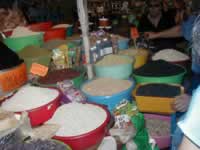 pyramids of
quesillo – Oaxaca’s own salty string cheese, and then,
finally a stop at Major Domo, one of the premier vendors of Oaxacan
chocolate. pyramids of
quesillo – Oaxaca’s own salty string cheese, and then,
finally a stop at Major Domo, one of the premier vendors of Oaxacan
chocolate.
When we got back to El
Naranjo, a table for twelve was set, the ruby colored glasses of
jamaica matching the tablecloth, and we were
served with panache by Iliana’s staff. Incredible to imagine
any appetite could be left after all the snacking in the kitchen,
but most of us managed! What a meal! And what a great experience!
Thank you, Iliana. It was the most memorable experience of our trip.
Sopa de Tortilla
© Restaurante El Naranjo, 2003
Serves 6
10 tortillas, day old (allow to air dry)
½ medium onion
2 medium garlic cloves, unpeeled
3 medium tomatoes
1 ½ tablespoons vegetable oil (canola)
1 ½ quarts chicken broth (boil whole chicken with garlic and
onion, simmer and skim froth)
3 sprigs fresh epazote (epazote is a wild spinach)
vegetable oil for frying
2 chile pasilla
1 cup queso fresco, cubed (garnish)
1 large avocado, cubed (garnish)
½ medium onion, diced (garnish)
½
cup crème fraiche
½
cup chicharrón (fried pork skin, available in Latin markets)
(garnish)
2 jalepeño chiles, chopped (garnish)
• Cut the tortillas
into julienne strips. And allow to air dry overnight.
• In medium sized skillet, dry roast the tomatoes, onion and unpeeled
garlic. Remove the garlic when it shows black spots, and leave the
onion and tomatoes until well roasted, about 10 minutes. Peel the
garlic and transfer it along with the roasted tomatoes and onion
to the blender. Add water (enough for blender to work) and blend
to a smooth puree.
• Heat 1.5 tablespoons of oil in a medium size saucepot, add the tomato
puree, and fry for 3 minutes or until it changes color. Add the chicken
broth and epazote springs, add salt to taste, and let boil gently
for 10 minutes. Remove epazote sprigs if you wish.
• Meanwhile, while soup is simmering, cut crosswise the pasilla chiles,
remove seeds and stems. To make chile rings, heat the oil in a medium
sized skillet, and, when it is hot, add the chiles, turn off the
fire and remove the rings immediately with a slotted spoon. Reheat
the same oil and add small batches of tortillas chips. Fry until
golden, transferring with slotted spoon into paper towels to drain.
• Divide tortillas into six serving bowls, ladle in the soup. Serve
immediately along with garnishes.
***********
(Note: This soup is very
forgiving. I just made it, but I added a few extra tomatoes, cut
back a bit on the broth, used baby spinach
leaves instead of epazote, skipped the chili, jalepeño and
chicharrón garnishes, and substituted tofu for the queso fresco!
It was as delicious as the original!)
|